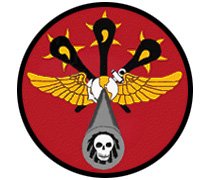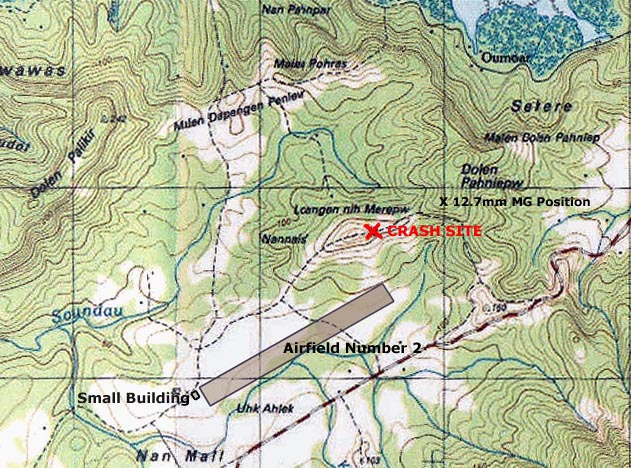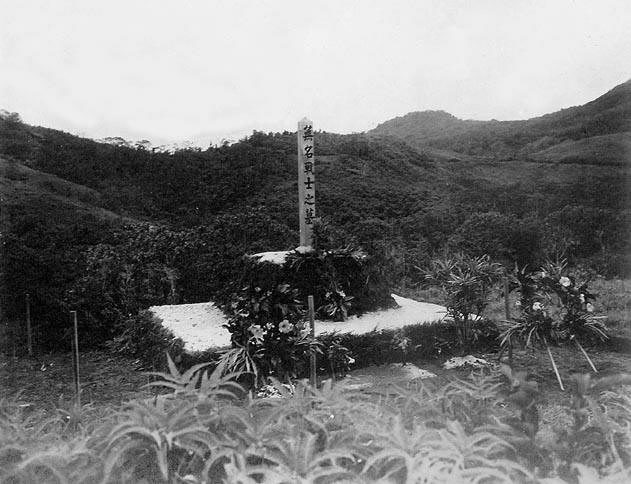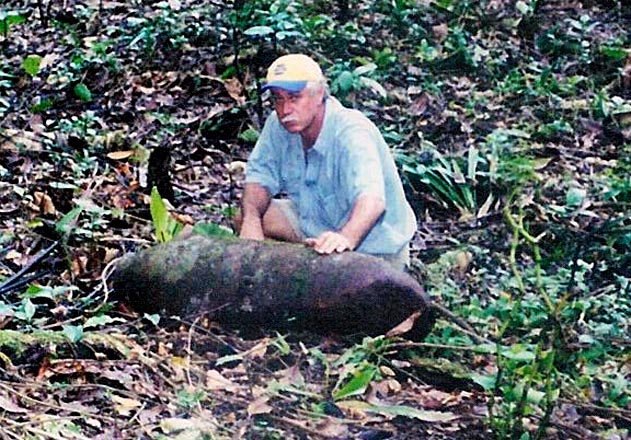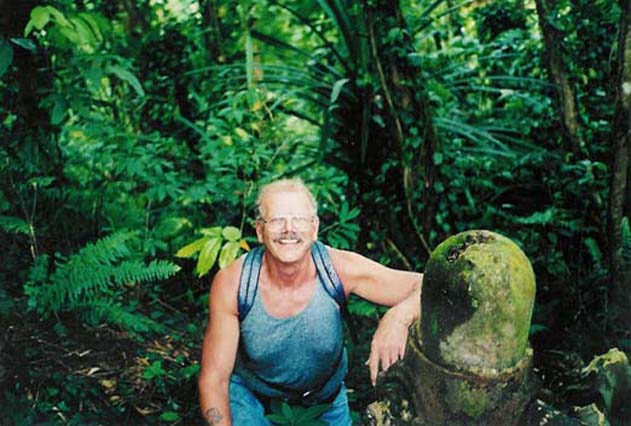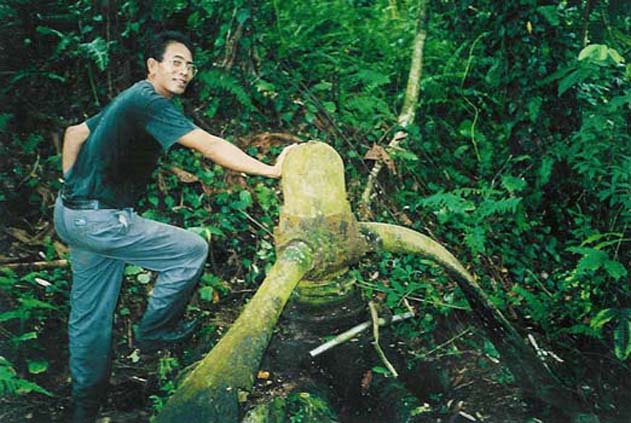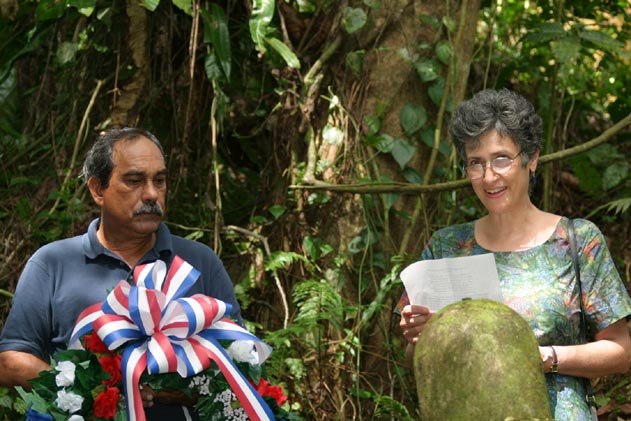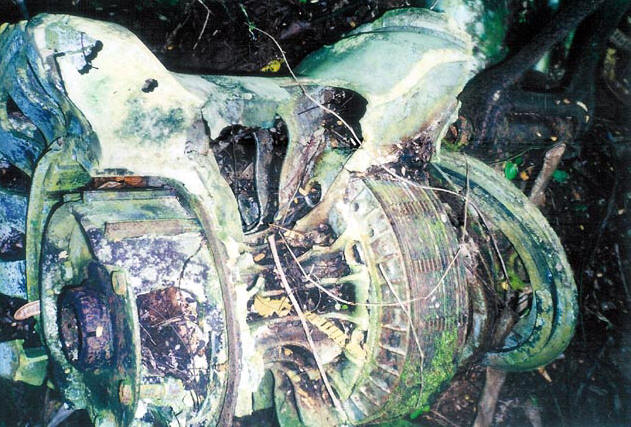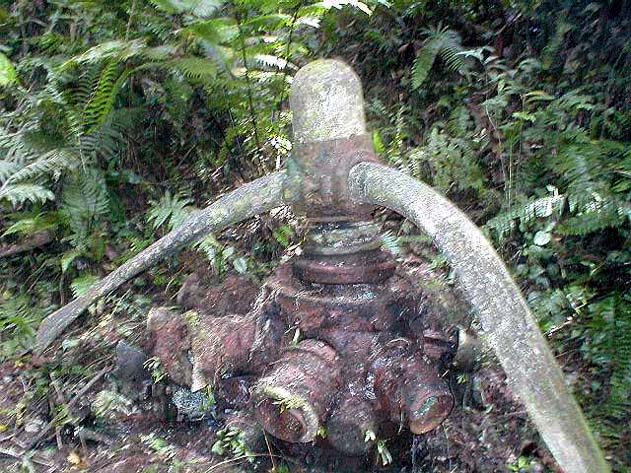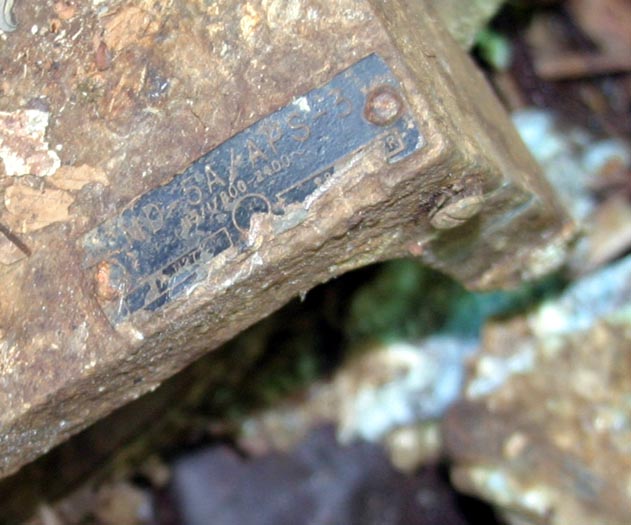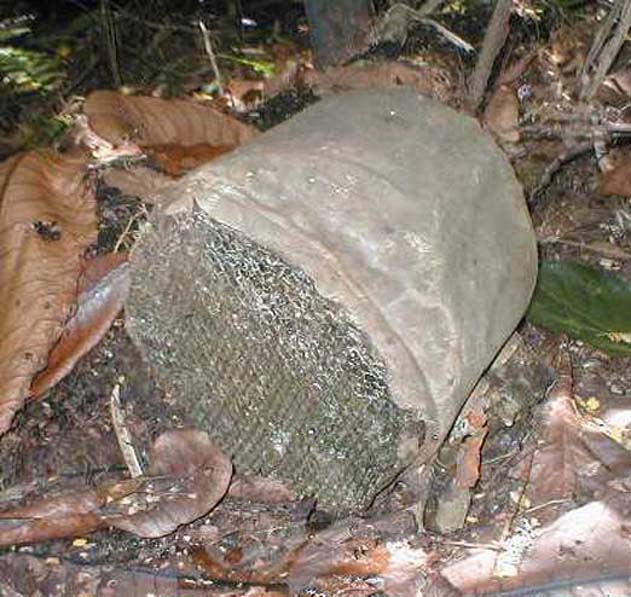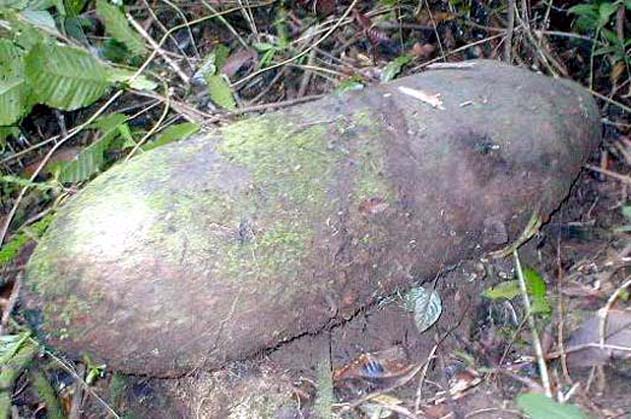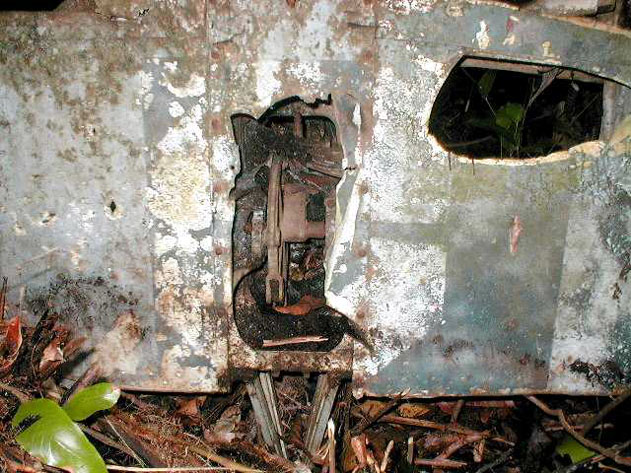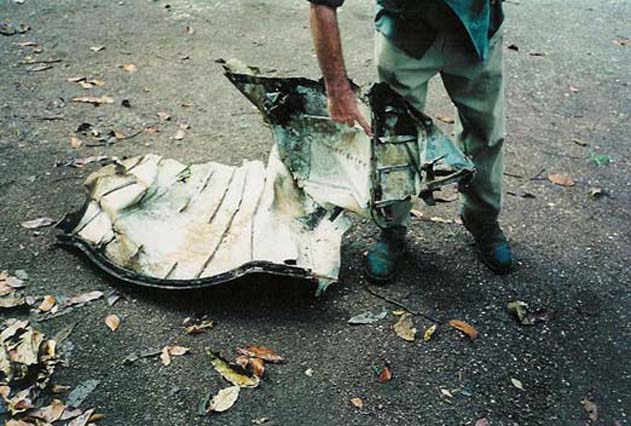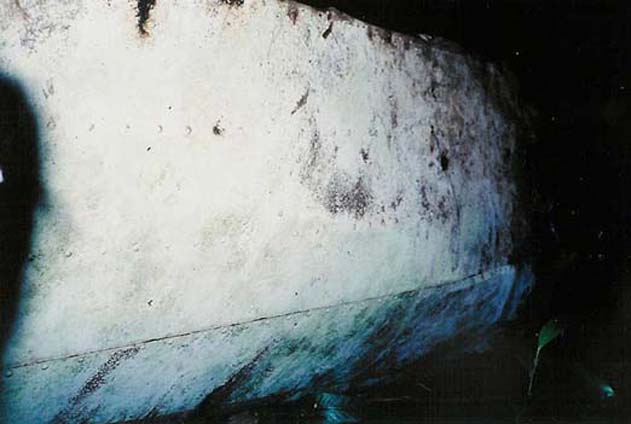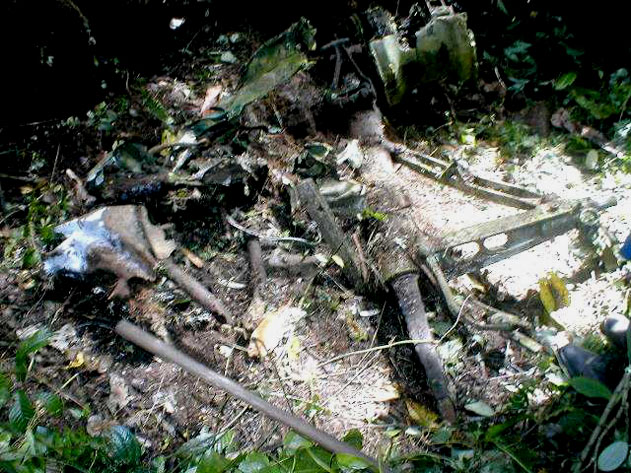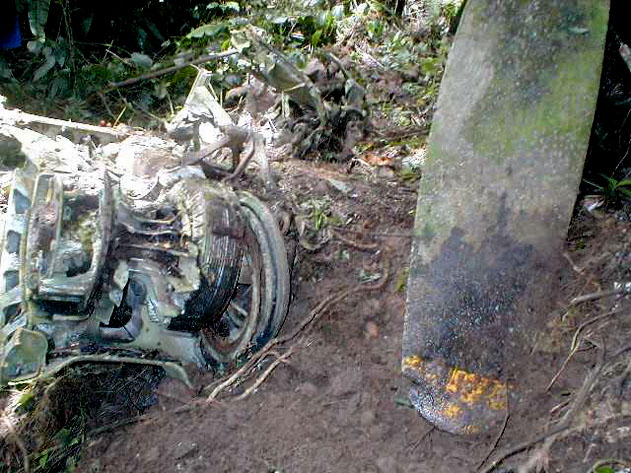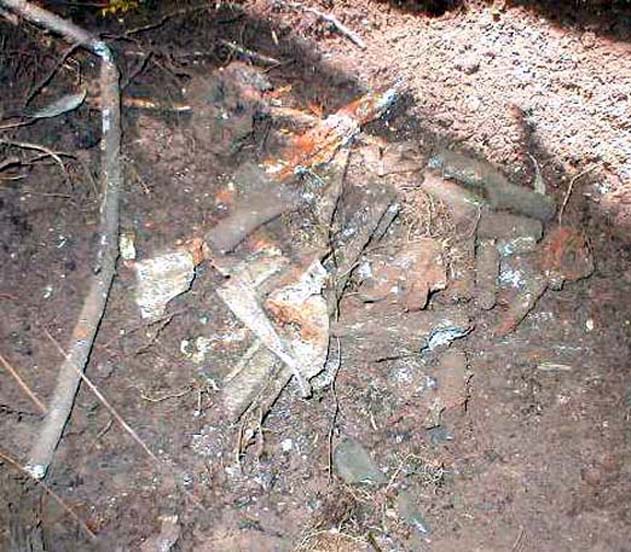|
|
||
|
|
||
|
|
PONAPE CRASH-SITE: PAGE 1 The story of MB-6 and its crew that was lost over Ponape did not end on February 6, 1945. Through the efforts of Stan Gajda and Dick Williams, the events of that day have been revealed from a forensic perspective through numerous hours of research, interviews with witnesses, and surveys of the crash site. During July of 2001, aviation archeologist Dick Williams traveled to Ponape to conduct a survey of the crash-site of MB-6, believing it to be a 7th Air Force B-25. Arriving on Ponape, Dick teamed up with his long-time friend, Stan Gajda, an aviation historian and aircraft restorer whose credentials included assisting in the recovery of the remains of nineteen men of Carlson's Raiders that were killed on Makin Atoll in 1942. As a resident of Ponape, Stan was very familiar with the crash-site. Work began with Dick Williams interviewing Estanis Aldis, a witness to the downing of the aircraft. Mr. Aldis indicated that he watched the attack on Airfield Number 2 on February 6, 1945 from a hill overlooking the airfield (Dolen Palikir) and that he recalled that the last plane was hit in the tail by "a small gun atop Dolen Pahniepw." He indicated that the plane "went straight in" and began to burn upon impact. Shortly thereafter, one of the aircraft's bombs exploded. He ran down the hill to the site of the crash, only to be chased away by Japanese soldiers who had arrived on the scene. According to Mr. Aldis, the Japanese recovered the bodies of five crewmembers, and buried them in a common grave at the crash-site, however the remains of the sixth crewmember could apparently not be located. It was also learned that Captain Kitawaga of the Imperial Japanese Navy had been the commander of the construction and defense at Airfield Number Two, and that following the war, the brother of the missing crewman had traveled to Ponape to search for him but was unable to locate his remains. With his interview of the witness complete, Dick and Stan traveled to the crash site and began a systematic search of the area. Their search revealed that only a few large pieces of the aircraft remained—the port engine and propeller, the port landing gear and wheel, three defused General Purpose bombs, and a section of the port vertical and horizontal stabilizer. The location of the vertical stabilizer proved an important find since it was the only piece of aircraft with recognizable markings, a large white "5" on a blue background. Excavation at the site revealed a "burnt area" of ground and further pieces of the aircraft including a bomb rail, and the shattered remains of a radar receiver. Smaller fragments included a buckle, a lens, pieces of switches, metal forgings, cloth fabric, and great deal of .50 caliber ammunition, shell casings, and projectiles. Dick and Stan also searched the area of the Japanese gun location atop Dolen Pahniepw and recovered a number of 12.7mm shell casings that had been fired, one of which may have held the fatal round. Following the search of the crash-site, Dick Williams returned to the United States and began researching the identity of the aircraft through the National Archives. His search revealed that the aircraft was in fact a Marine PBJ-1H belonging to Marine Bombing Squadron Six-Thirteen, and that its Bureau of Aeronautics number was 35275. With this information, Dick was able to contact a number of squadron members and learn additional historical details. In corresponding with members of VMB-613, Dick learned that following the war American service personnel traveled to Ponape as part of a War Crimes Tribunal, and that one of the members of that tribunal had been First Lieutenant Donald C. McCune, the Assistant Intelligence Officer of Marine Bombing Squadron Six-Thirteen. During their inquiry, the tribunal learned that following hostilities, the Japanese had erected a monument "to the brave American flyers" over the gravesite of MB-6's crewmen. He also learned that sometime thereafter, the bodies of the crewmembers were removed from the grave at the crash-site and temporarily re-interred in Kolonia, the primary port village on Ponape, before being repatriated to the United States and buried at the Jefferson Barracks National Cemetery in Saint Louis, Missouri. During the spring of 2004 both Dick and Stan were contacted by members of VMB-613 concerning the status of one of the crewman, Sergeant David Snider. Based on the fact that Sergeant Snider was not buried with the rest of the crew in Saint Louis, squadron members wanted to know whether either Dick or Stan had any information that his remains had ever been recovered. Reviewing their notes from 2001, neither Dick nor Stan could find any evidence to indicate that the sixth crewman's remains had ever been located. Dick and Stan advised squadron members to contact the U.S. Army Central Identification Lab and ask for verification of the status of Sergeant Snider's remains, and if necessary, an excavation of the entire crash-site. Acting on this recommendation squadron members submitted their official request and anxiously awaited a response. During the interim, Stan planned another trip to the crash-site to see if he could locate any additional evidence. In early May of 2004 Stan and his friend, aviation archeologist Russell French, returned to the crash-site to see if any evidence of Sergeant Snider could be found. Following an exhausting day of searching, some additional aircraft artifacts were located and documented as well as a Japanese searchlight, however no evidence of Sergeant Snider was discovered. The following month, a long-awaited response from the Casualty Section at Headquarters Marine Corps was finally received. It indicated that the remains of Sergeant Snider had been recovered and identified in 1948, and that he had subsequently been buried at Riverside Cemetery in Rochelle Park, New Jersey in 1949. Verification of Sergeant Snider's burial at Riverside Cemetery was obtained from the cemetery staff shortly thereafter. The efforts of Dick Williams and Stan Gajda will always be remembered, as they have provided squadron members with answers and closure to the 58 year old mystery of their unaccounted-for comrade. A new chapter in the story of the of MB-6 began in late December 2004 when squadron members were contacted by Stephen A. Druzak, Deputy of the United States Embassy located on Pohnpei (Ponape). Steve contacted squadron members seeking information pertaining to the exact time that MB-6 was shot down, as he was planning a memorial ceremony for the crew on the sixtieth anniversary of their loss. The necessary information was passed to Steve, and at 11:15 AM on February 6, 2005 a well-attended memorial service was conducted at the location of the remaining engine by Ambassador Suzanne K. Hale, and the Speaker of the Congress for the Federated States of Micronesia, Peter Christian. The ceremony was a moving experience, and as one attendee stated, "... the boys were remembered with respectful, dignified and kind words concluding with a tearful rendering of Taps." Additional information regarding that ceremony, including a list of those attending is provided at: Memorial Service.
CRASH-SITE MAP: Approaching the target (Airfield Number 2) from the northeast, MB-6's wing was blown-off by 12.7mm machine gun fire from a Japanese anti-aircraft position on Dolen Pahniepw. The aircraft then spun end-over-end, crashing and exploding just short of the airfield. The location of the actual point of impact is 6° 55' 47" N, 158° 10' 2"E.
GRAVE OF BILL LOVE AND HIS CREW: Following the end of hostilities, the Japanese on Ponape erected this monument over the grave of the crew of MB-6. Japanese characters on the monument explain that it is the "Grave of American Airmen." Photograph: U.S. Marine Corps, Arthur H. Navarre Collection (Courtesy of Diane Hindy)
STAN GAJDA: Historian and aircraft restorer Stan Gajda has conducted numerous expeditions to the crash site of Bureau Number 35275 on Ponape, most recently in May of 2004. Here, Stan kneels beside a 500 pound bomb from MB-6. Photograph: ©2001 Richard D. Williams
DICK WILLIAMS: Aviation archeologist Dick Williams conducted extensive research, interviews with witnesses to the events of February 6, 1945, and a survey of the crash site of MB-6. Photograph: ©2001 Richard D. Williams
RUSSELL FRENCH: Aviation archeologist Russell French accompanied Stan Gajda during the May 2004 survey of the crash site. Russell is seen with one of the three remaining bombs from the aircraft's bomb load. Photograph: ©2001 Richard D. Williams
SEKERIAS: Sekerias, a resident of Ponape and long-time friend of Dick Williams, obtained permission from the land owner for the 2001 survey of the crash site. Photograph: ©2001 Richard D. Williams
MEMORIAL SERVICE: Speaker of the Congress for the Federated States of Micronesia, Peter Christian, and United States Ambassador, Suzanne K. Hale laid a wreath at the crash-site of MB-6 on the sixtieth anniversary of the loss of the aircraft and its crew. The hub of the port propeller can be seen directly in front of Ambassador Hale. Photograph: ©2005 Stephen A. Druzak
SHATTERED MAIN WHEEL: The wheel from the port side main landing gear of MB-6. The tire has long since disappeared. Photograph: ©2001 Richard D. Williams
ENGINE: Located only 50 feet from the impact point, the port engine of MB-6 bears mute testimony to the violence of the crash. The engine, propeller and part of a landing gear are the largest pieces of wreckage from Bureau Number 35275. As a result of souvenir hunters, one propeller blade is missing, while a second one has had its tip sawed off. Photograph: ©2001 Richard D. Williams
REMNANT OF AN/APS-3 RADAR: A part of the AN/APS-3 search radar from MB-6 was identified by the manufacturer's plate, still attached after 60 years. This part was discovered in January 2005 when Steve Druzak visited the crash-site. Photograph: ©2005 Stephen A. Druzak
OIL COOLER CORE: Wreckage from Bureau Number 35275 on Ponape - The core of a Serrek oil cooler. Photograph: ©2001 Stan Gajda
500LB BOMB: One of three 500 pound general purpose bombs that remain from MB-6's bomb load. The fourth bomb exploded following the crash. Photograph: ©2001 Stan Gajda
EMPENNAGE: The port side of the horizontal and vertical stabilizer. The vertical stabilizer is in the foreground. Photograph: ©2001 Richard D. Williams
VERTICAL STABILIZER: A close-up of the vertical stabilizer with the control cable pulley still in place. A large white "5" is visible on the faded blue background. The number "5" was part of the aircraft's originally assigned number, used while it was based at Newport, Arkansas. This number, along with a second digit applied to the rudder, was subsequently painted over with a dark colored rectangle. A slightly smaller "6" was then stenciled over the rectangle once the aircraft arrived in the Marshall Islands. Photograph: ©2001 Richard D. Williams
STABILIZER FAIRING: Part of the horizontal stabilizer. The curved part on the left of the photograph is the fairing where the horizontal stabilizer attached to the fuselage. Photograph: ©2001 Richard D. Williams
HORIZONTAL STABILIZER: The underside of the horizontal stabilizer reveals white paint intact after sixty years. Photograph: ©2001 Richard D. Williams
LANDING GEAR: The remnants of the engine mount, and the port landing gear strut and wheel of MB-6. Photograph: ©2001 Stan Gajda
PROPELLER AND MAIN WHEEL: In January of 2005, Steve Druzak visited the crash-site of MB-6 and took this photograph of the port engine, propeller, and main landing gear. Despite the obvious violence of the impact, Steve reported that he found that the safety wire on one of the points connecting the dome covering the pitch control mechanism to the prop hub, intact. Photograph: ©2005 Steven A. Druzak
LOCATING ARTIFACTS: Stan arefully sifting through underbrush, Stan Gajda discovers a piece from the aircraft's radar receiver. Photograph: ©2001 Richard D. Williams
FRAGMENTS: Small metal fragments, shell casings, and projectiles from MB-6. Photograph: ©2004 Stan Gajda |
|
|
Copyright © 2008 Marine Bombing Squadron Six-Thirteen Association. All Rights Reserved. |
||
